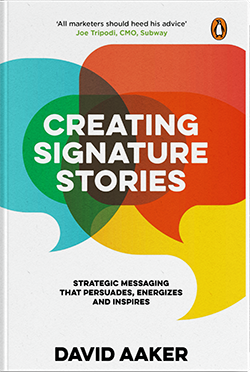Stories work better than facts. A set of facts are often ignored or treated as self-serving with claims that are not credible. Consider the remarkable impact of some signature stories at Barclays, which had become the least trusted brand in the least trusted industry and need to repair their image.
Barclays – How a Brand Regains Trust
Barclays is a role model for how to use stories in a brand crisis to regain trust and change the conversation. The Barclays brand, which had suffered from the 2008 financial meltdown, was later damaged by accusations that Barclays and other banks had manipulated key interest rates. The trust level for Barclays in Britain in 2012 was well below that of its competitors. It is not a stretch to conclude that Barclays was the least trusted brand in the least trusted sector in the UK. Barclays in response announced a new brand purpose: “Helping people achieve their ambitions—in the right way” and organized efforts to get their 140,000 employees on board.
Employee-Inspired Higher Purpose Programs
The newly empowered and inspired Barclays employees created and led dozens of higher-purpose programs on their own. One, the Digital Eagles, is an internal group that grew to over 17,000 employees. Its mission is to teach the public about surviving and even thriving in the digital world. Stories about how Digital Eagles projects affected real people helped shine a light on the higher-purpose initiatives at Barclays.
One story featured Steve Rich, a sports development officer, who had lost his ability to play football (soccer to Americans) because of a car accident. But he could participate in “walking football”—usually played with a team of six on a small field with no running—which enabled him to again experience the joy of the sport. Wanting to help others do the same, he decided to raise awareness of walking football and turn it into a nationwide game in Britain. With the help of Digital Eagles, Rich created a website that connected over 400 teams across the country–and connected individuals with teams. It also helped Rich get in touch with some former football mates. He is partly responsible for the growing interest the sport has generated as reflected in the emergence of a national tournament. His accomplishments and personal regeneration is inspiring indeed.
“The new campaign drove six times as much change in trust and five times as much change in consideration as the product-focused campaign that preceded it.”
Employees were inspired and energized by the programs driven by the new brand’s purpose. And customers and prospective customers changed their perceptions of Barclays. From the start of the campaign to tell signature stories about the Digital Eagles and other programs in the summer of 2014 until early 2016, trust was up 33 percent, consideration was up 130 percent, the emotional connection was up 35 percent (versus 5 percent for the category average) and “reassurance that your finances are secure” was up 46 percent. The new campaign drove six times as much change in trust and five times as much change in consideration as the product-focused campaign that preceded it. By 2015, Barclays received 5,000 positive mentions in the press.
How Do Signature Stories Persuade?
Stories get heard and change minds. More particularly, stories like those used by Barclays, persuade because they:
1. Attract attention.
When a speaker says, “Let me start with a story,” your attention shifts and focuses. But when a speaker talks in the abstract, communicating only facts without a story, your attention wanders. It just does. Customers and employees are seldom interested in your facts. Stories fare best when they are engaging from the outset, have detail that allows you to visualize and empathize, and have a fresh and intriguing storyline.
2. Inhibit counter-arguing.
The power of the story can distract the recipient and can reduce the tendency to confront or counter the facts shared. Since the messaging isn’t contradicted or refuted, it’s more likely to be processed and accepted. As a result, storytelling is especially effective when attempting change or when softening negative positions—the task that Barclays faced.
3. Involve an authentic, credible and likeable storyteller – one who doesn’t relay dry facts.
By simply telling a story, a brand spokesperson can deliver a point without being perceived as phony, contrived or a commercial selling vehicle.
4. Allow people to deduce logic themselves.
We know from research and common sense that self-discovery is much more powerful than having people talk at you. The Barclays stories suggest to the audience about the values and priorities of the organization. The audience needs to make the leap to perceptions of trust on their own. There wasn’t anyone explicitly telling customers to trust Barclays.
5. Are remembered.
Stories are remembered more than facts because the story recipient is more attentive and involved than the same person receiving a recitation of facts. In addition, the story arc provides a way to organize information and becomes, in essence, one thing to remember rather than a set of facts.
6. Are shared.
Gaining the attention of one audience also offers the possibility of reaching others—via social media. This can multiply the exposed population—and send some stories into viral territory. Passing along a signature story also enhances its ability to gain and keep attention. You are likely to spend time with a story if someone you respect and consider unbiased is delivering and/or endorsing it. That source is often putting his or her reputation on the line, so you will probably approach the story with a positive attitude.

